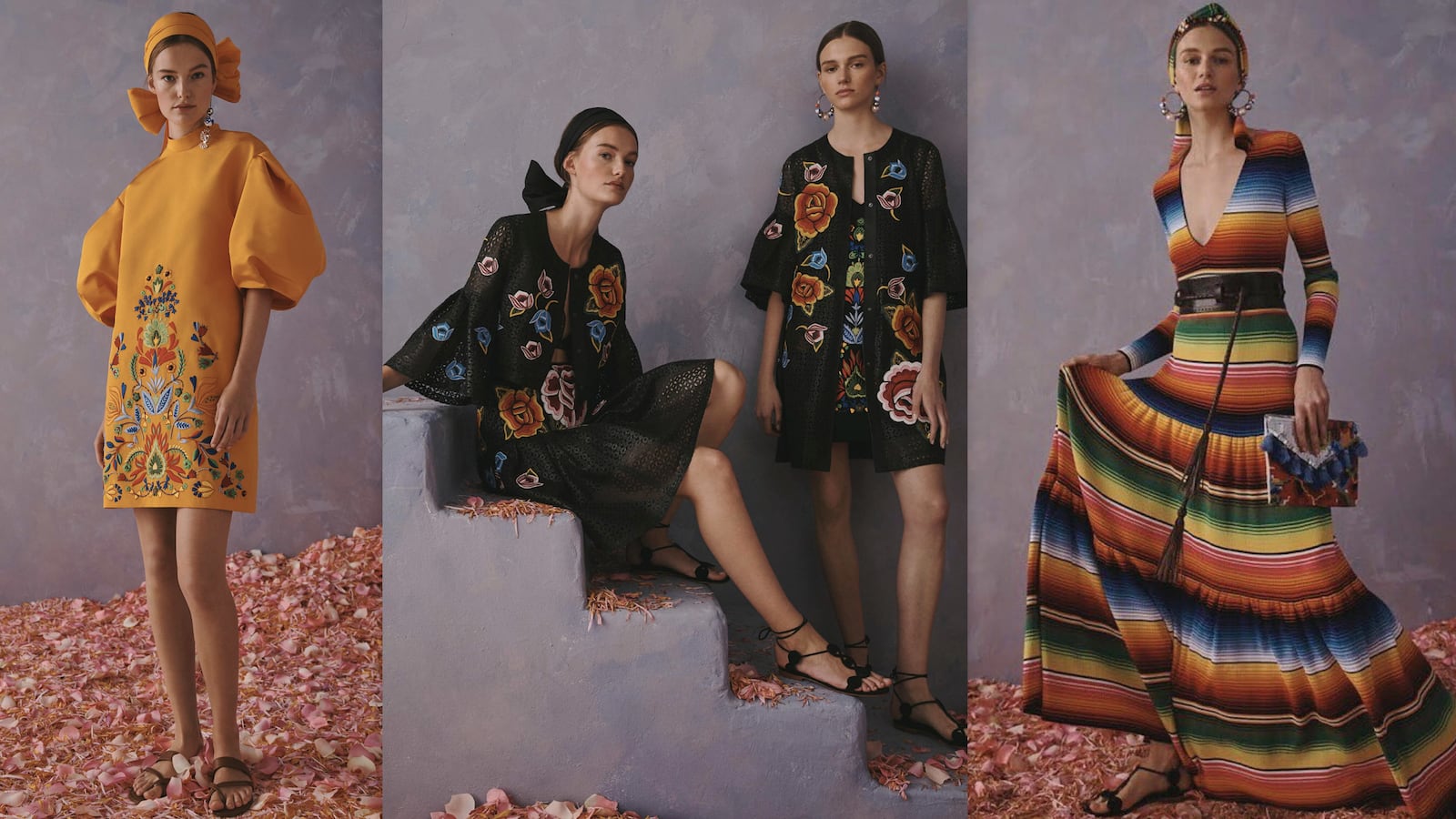Earlier this month, Vogue Runway director Nicole Phelps previewed Carolina Herrera’s 83-piece resort collection. Phelps noted the lineup, designed by the brand’s young creative director, Wes Gordon, “plays up Herrera’s Venezuelan side.” (Herrera, 80, was born in Caracas but has floated through New York society since the late 1960s.)
“The colors, patterns, and embroideries of Latin America have been applied to the kind of occasion dress that Herrera’s ‘uptown’ clientele requires,” Phelps wrote. “A standout clingy ripped knit dress was printed in vibrant serape blanket stripes, and a strapless gown has been embellished in the traditional embroideries of Oaxaca [Mexico].” By Vogue’s estimate, the line was a hit, “going to fly” off shelves.
What a difference one week and an international political crisis makes.
On June 13, the Spanish newspaper El Paìs reported that Alejandra Frausto, Mexico’s secretary of culture, sent a letter to Gordon and Herrera accusing both of cultural appropriation.
Frausto asked the team to “publicly” explain why and how the collection used traditional Mexican design elements. The secretary also inquired if Mexican craftspeople would be compensated for their designs.
The serape-printed knit dress approved by Vogue was called out as originating in Saltillo. Another “animal embroidery” motif repeated on a white gown came from Tenango de Doria in Hidalgo.
As Frausto explained, “In these embroideries is the history of the community itself and each element has a personal, family, and community meaning.”
The secretary’s letter was more than just the latest entry in the long, exhaustive database covering fashion houses accused of cultural appropriation.
Per The Guardian, Frausto went on to write, “This is a matter of ethical consideration that obliges us to speak out and bring an urgent issue to the UN’s sustainable development agenda: promoting inclusion and making those who are invisible visible.”
Representatives for both the fashion house and Mexican government did not respond to The Daily Beast’s request for comment.
Could Gordon, reportedly inspired by a “Latin holiday,” face criminal charges for what Frausto dubs “plagiarism”?
The answer is, of course, probably not. Time after time, call-out culture will reveal a designer to have committed the sin of appropriation. A social media firestorm will ensue, clothes might be burned in protest, the designer will (hopefully) apologize, and the fashion world will bite its nails wondering who will be the next offender.
Last month, an anti-plagiarism bill designed to protect indigenous craftspeople was introduced to Mexico’s senate.
The U.N.’s 2030 Agenda for Sustainable Development, which Frausto referenced in her letter, takes no explicit stance on cultural appropriation.
The sweeping, 35-page outline details a “plan of action for people, planet and prosperity” aimed at eradicating global poverty, “free the human race from the tyranny of poverty and want [and] heal and secure our planet.”
Part of the document’s tenth page reads,“Pledge to foster intercultural understanding, tolerance, mutual respect, and an ethic of global citizenship and shared responsibility. We acknowledge the natural and cultural diversity of the world and recognize that all cultures and civilizations can contribute to, and are crucial enablers of, sustainable development.”
That jumbled word salad could swing both ways. If you’re anti-cultural appropriation, the phrase “foster intercultural understanding, tolerance, and mutual respect,” could read like a warning over appropriation to designers in the crafting of clothes.
But the following sentence — “all cultures and civilizations can contribute to. . .” — celebrates a proverbial “melting pot” where shared influences are celebrated.
U.N. representatives did not reply to The Daily Beast’s inquiry by press time.
“Anything that comes through the U.N. tends to be vague diplomatic and advisory,” Susan Scafidi, a lawyer and director of Fordham’s Fashion Law Institute, told The Daily Beast. “When intangible properties are copied, nothing is actually taken away from its owners, so it’s a little hard for the international community to wrap its mind around protections.”
The delay is not for lack of trying. As Canada’s CBC reported in 2017, delegates representing the U.N.-affiliated World Intellectual Property Organization have met since 2001 to craft anti-appropriation legislation.
Per the CBC’s story, University of Colorado Law School Dean Jim Anaya spoke to the committee suggesting the U.N. “obligate states to create effective criminal and civil enforcement procedures to recognize and prevent the non-consensual taking and illegitimate possession, sale and export of traditional cultural expressions.”
Two years later, Mexico’s letter reinvigorates an 18-year effort. But even if the U.N. were to finally come down on appropriators, actually enforcing it might prove difficult.
“More than likely, this would take the form of a treaty that countries were asked to sign and adhere to,” Scafidi suggested. (Surely, an administration that backs out of the Paris Accord might drag their feet at agreeing to a cultural appropriation ban.)
In the U.S., federally registered Native American tribes are protected by The Indian Arts and Crafts Act of 1990. It is illegal to sell goods that “falsely suggest” to be “Indian-produced.”
In one famous 2012 case, the Navajo Nation took Urban Outfitters to court for selling printed “Navajo flasks” and “Navajo hipster panties.” Four years later, both parties settled, agreeing to collaborate on a line in the future.
For his part, Gordon told New York Times fashion critic Vanessa Friedman that his team spent Thursday considering how to respond to Mexico’s letter.
“We are going through a big social shift in how we talk about gender, culture, and identity,” Gordon said. “These are important discussions to have. We take this very seriously.”
Gordon’s careful words demonstrate that there are no easy answers—or solutions—when it comes to talking about cultural appropriation.
Criminalizing the longtime practice will be doubly hard. After all, as Scafidi put it, “Fashion raids the world’s closets for inspiration.”







